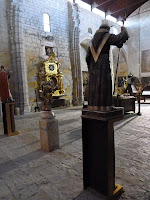 |
| cloister ceiling at San Zoilo, Carrion de los Condes |
But we have four dogs and ten chickens, a cat and a canary, and a house where people like to find us this time of year.
We cannot run away, not without somebody going hungry or lonely.
And so we wait for a day when no one is supposed to come, a sunny day usually, when nothing else is going on. And we get in the car and run away to somewhere not too far.
People say The Peaceable is "in the middle of nowhere."
But we always jump in and tell them no. The Peaceable is "in the middle of everywhere."
The region is peppered with historic sites, tiny private museums of farm implements and folk costumes and historic or architectural ephemera, Roman remains, mouldering convents, converted mosques, hermit caves... It´s a delicious mix, if you like this sort of thing.
Which we do, very much.
And Saturday, we ran away for just a few hours, and touched on no less than three wonders.
 |
| St. Martin family homestead |
 |
| Cervatos Boy Made Good |
The little town is plastered with plaques and commemorations. We asked about seeing inside the house, but the guy who keeps the keys was not in the plaza nor the bar up the street.
 |
| Cervatos´ Argentine church |
But if was too hot to wait around the Plaza, so we carried on east to Carrion de los Condes. In English, "carrion" means "dead animal carcass." In Spanish, it is the name of a river and a town and a ruling family made infamous in the medieval Spanish classic "El Cid."
 |
| the church at San Zoilo monastery |
Thousands of lives were lived inside those walls. Five times a day for hundreds of years that church rang with songs and music and worship. On Saturday, with the sun crashing through its high windows, it felt as empty as an airplane hangar. It is awesome in its size and age and forgottenness.
 |
| gargoyle |
It is a little treasure house, full of the very kind of thing you´d imagine finding in a pirate´s wooden chest: silver crowns, golden crosses, and rosaries made of coral, gilded statues, heavy keys, robes crisply crimped and embroidered with metallic threads by a hundred nuns in the far-off Phillippines.
 |
| Carrion parish museum |
From the church we walked past the Plaza Mayor to the Bar España, a crossroads where the Camino flows into town, and the bus to Leon stops and picks up the pilgrims who can´t take any more Meseta. It´s got prime people-watching tables set out on the pavement, and one of the biggest and finest gin-and-tonics on the trail. We had us one of those. And we took pictures of pilgrims taking pictures of one another.
From there we went to the Rincon de Hamburguesas, and ordered cheeseburgers and patatas bravas, and watched the crash-and-burn report from the Formula 1 races on the TV overhead. The food was wonderfully fatty -- a rarity in a place where all the beef is really veal. Paddy said it was vile, and that he loved it.
And then we hiked back over the river and through the woods to our car, and back to home we went. The dogs hardly had time to miss us. (we took them later to a little lake we discovered recently... my attempt at video is (hopefully) above.






